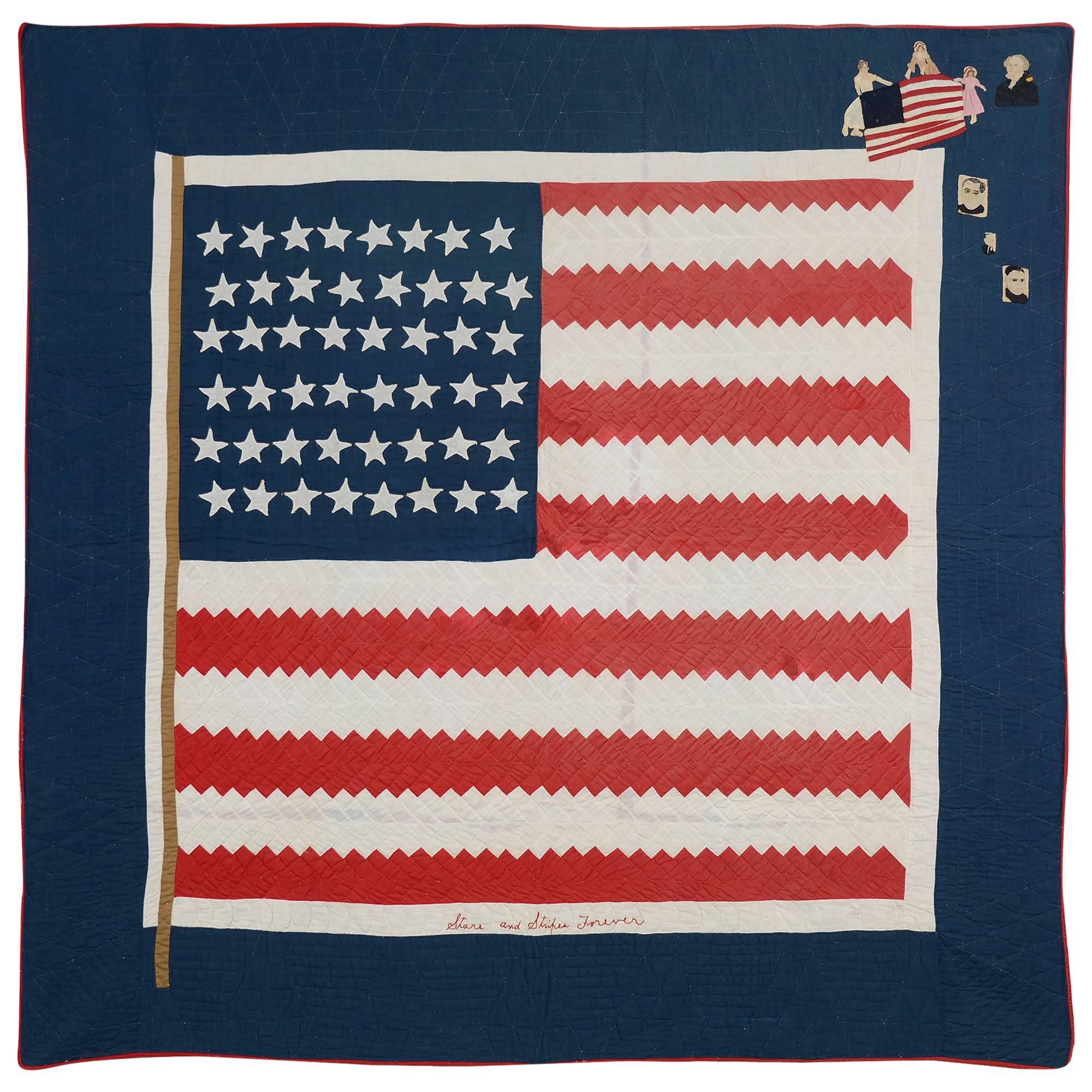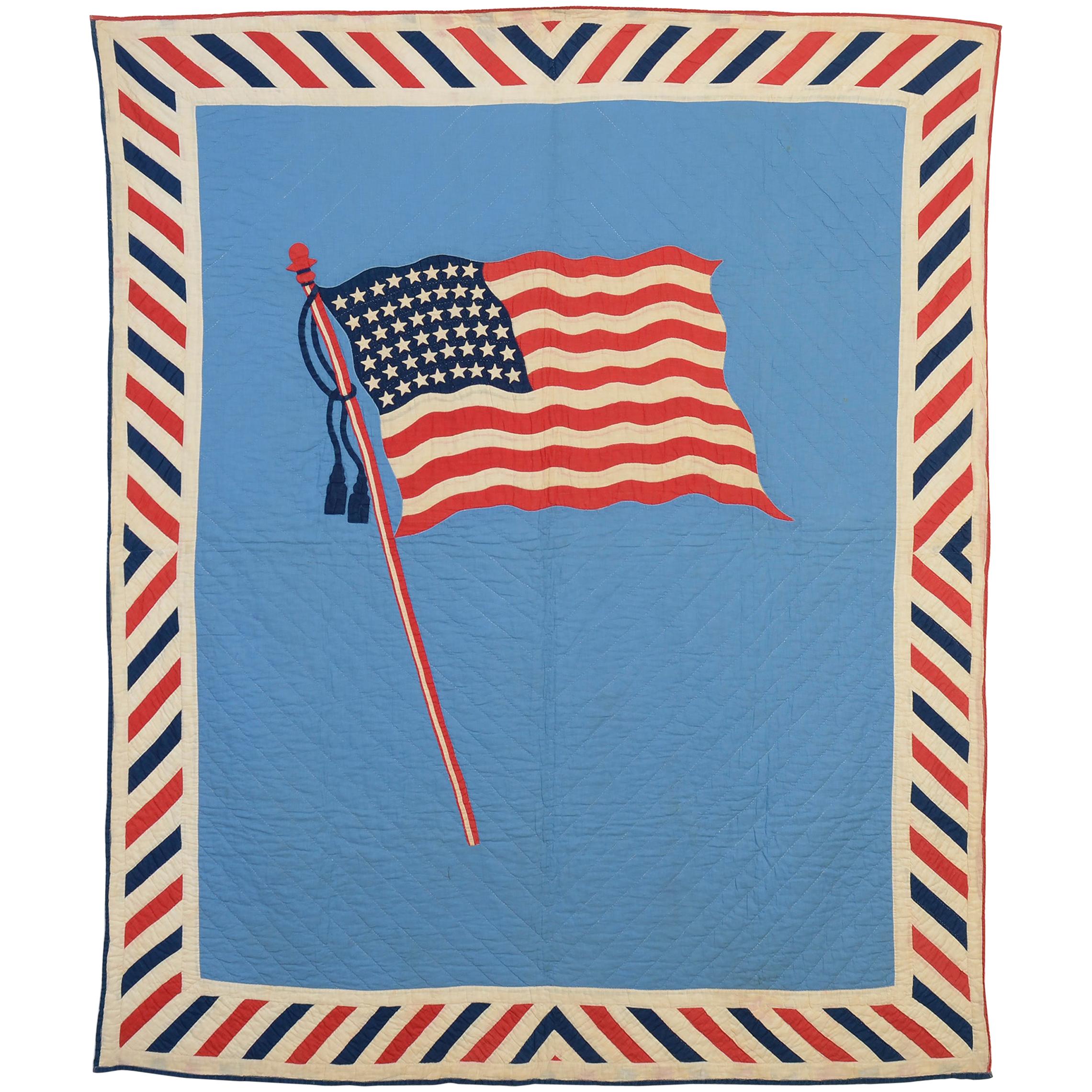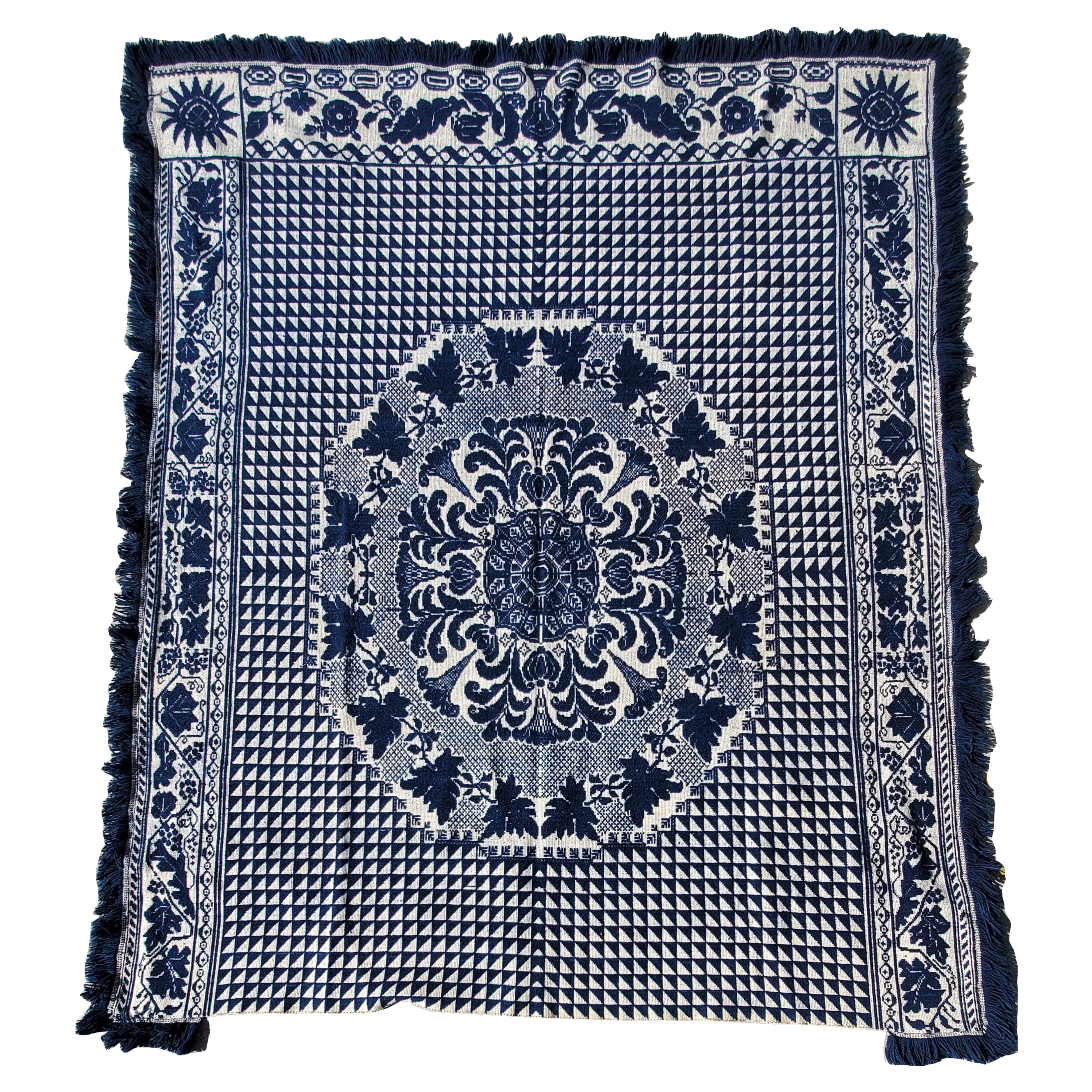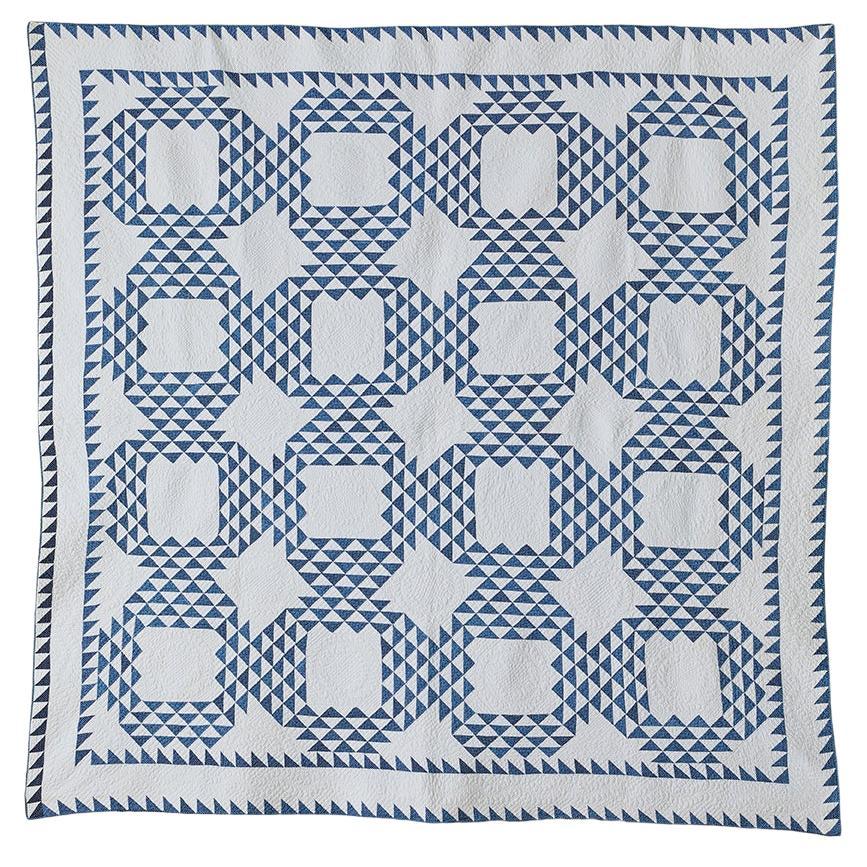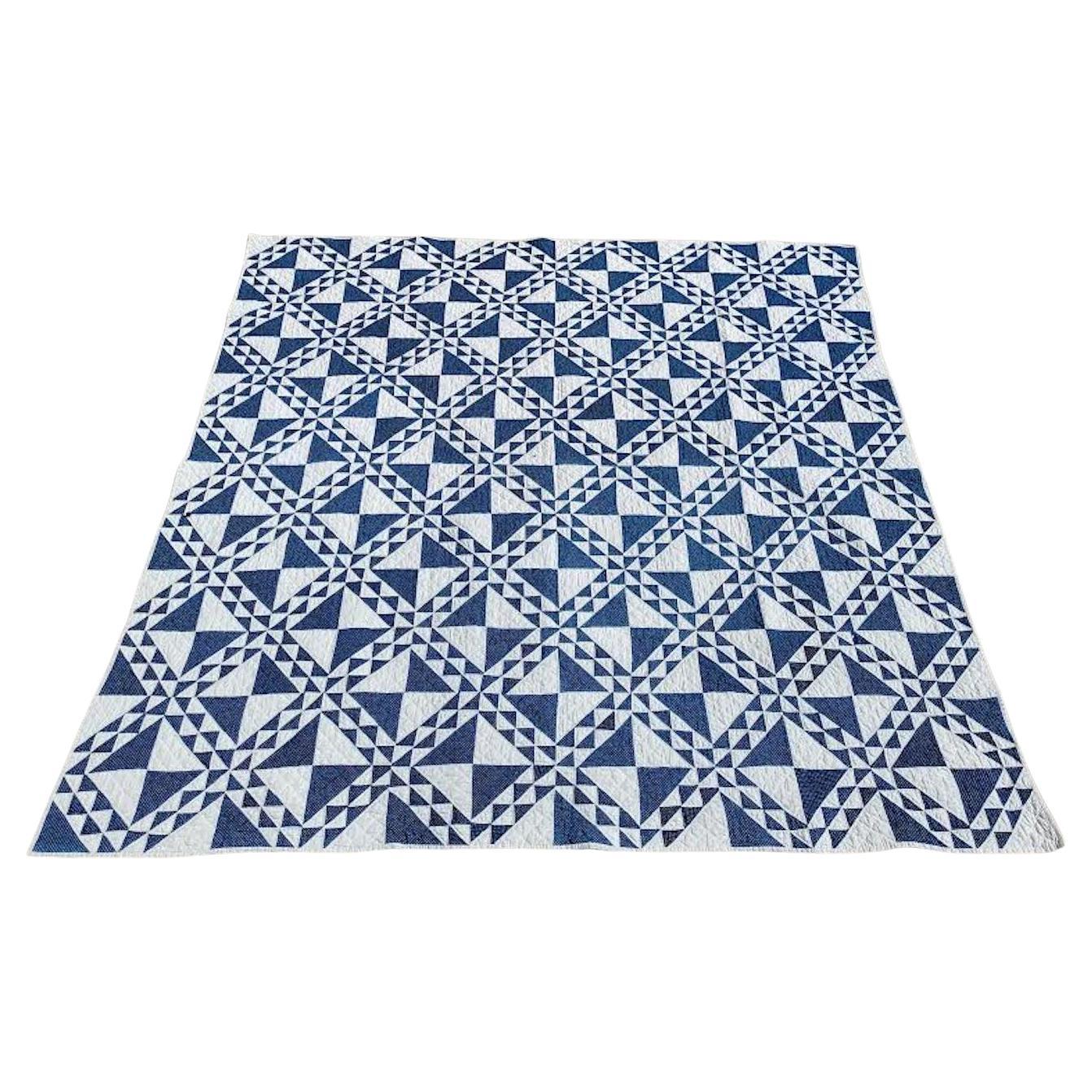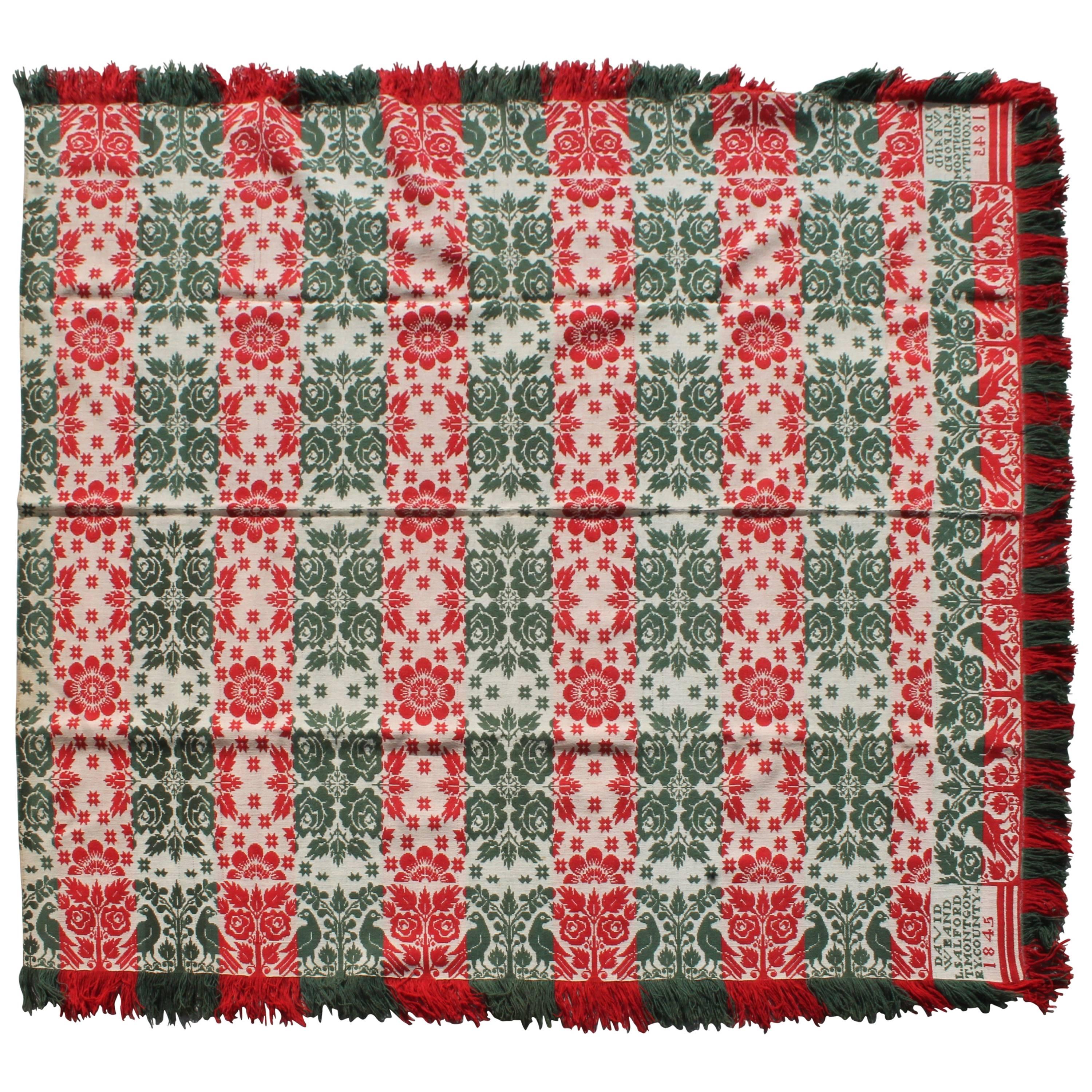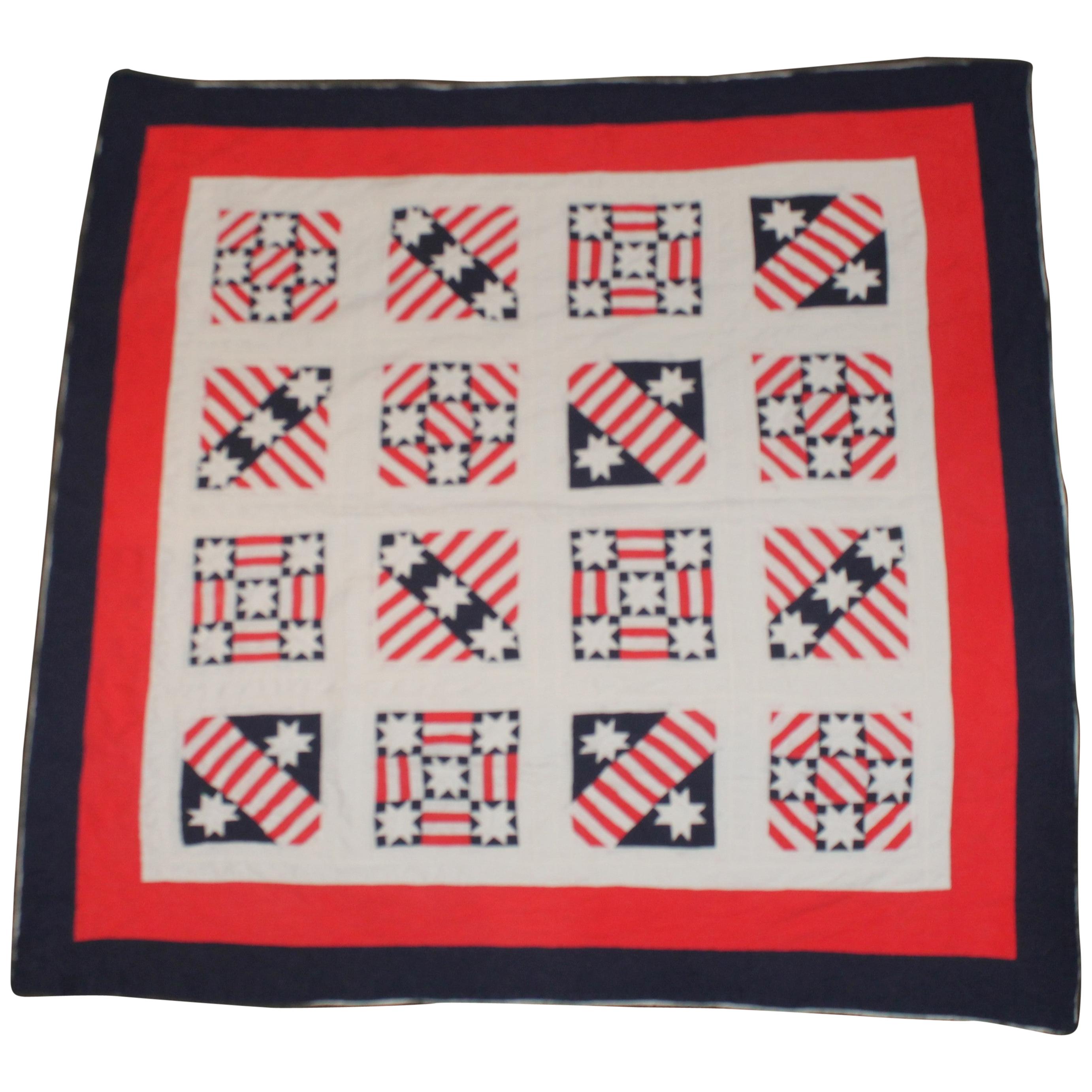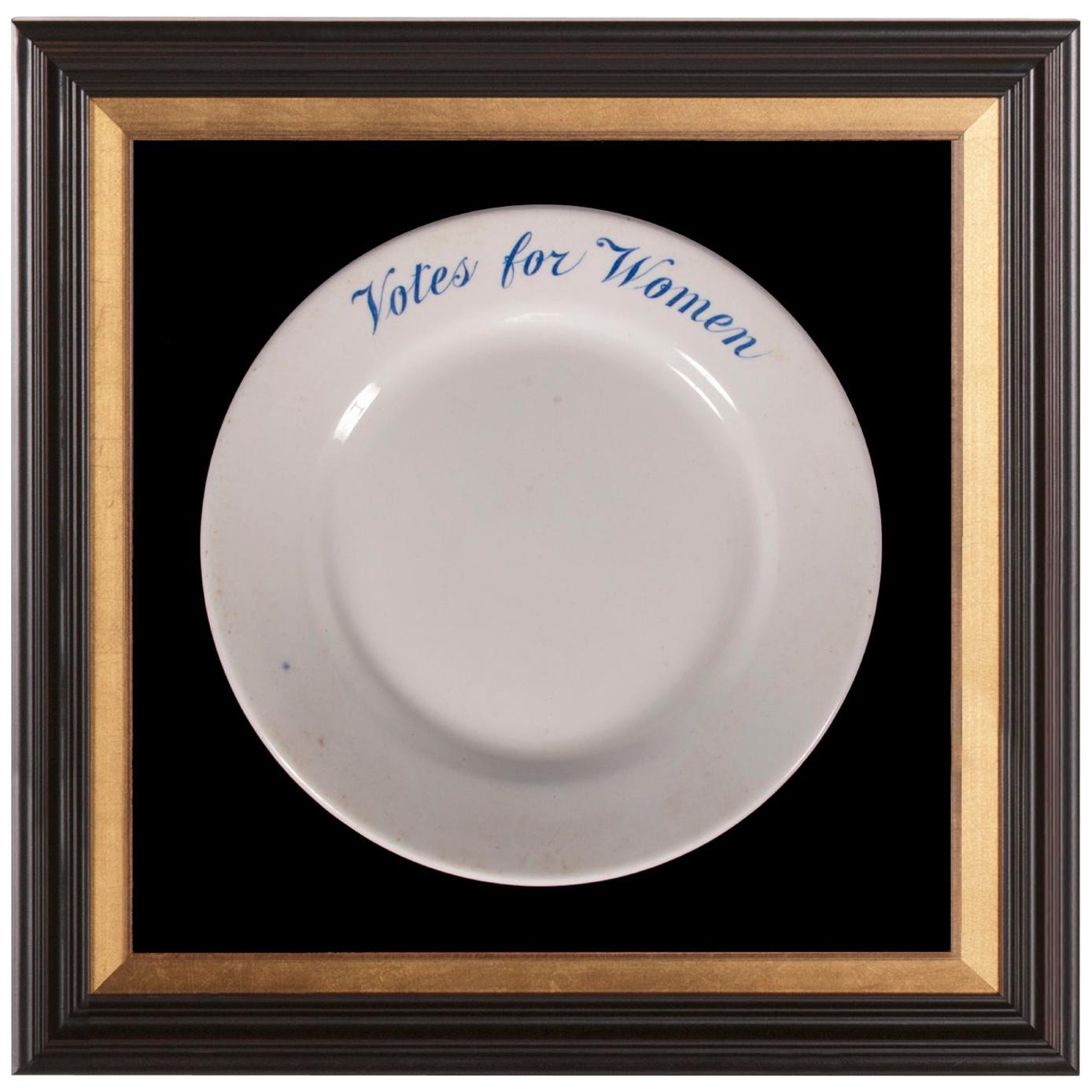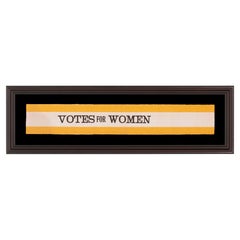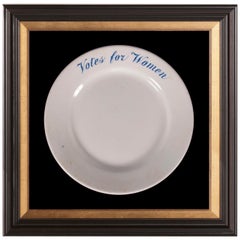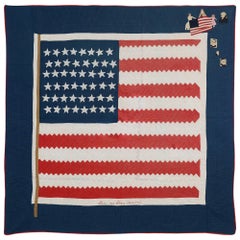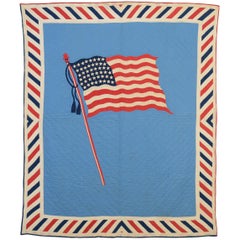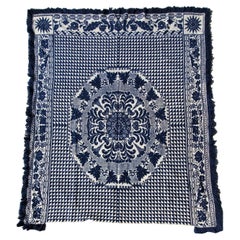
Blue and White "Liberty" Coverlet, Made in 1949 for Aurissa A. Gillett
View Similar Items
Want more images or videos?
Request additional images or videos from the seller
1 of 9
Blue and White "Liberty" Coverlet, Made in 1949 for Aurissa A. Gillett
About the Item
- Dimensions:Height: 87 in (220.98 cm)Width: 78 in (198.12 cm)Depth: 1 in (2.54 cm)
- Place of Origin:
- Period:1840-1849
- Date of Manufacture:1849
- Condition:See Item Description.
- Seller Location:York County, PA
- Reference Number:Seller: cov-0061stDibs: LU849710895071
About the Seller
5.0
Recognized Seller
These prestigious sellers are industry leaders and represent the highest echelon for item quality and design.
Established in 1991
1stDibs seller since 2008
61 sales on 1stDibs
Typical response time: 10 hours
More From This SellerView All
- "Votes for Women" Sash in Yellow and White, ca 1910-1915Located in York County, PASilk suffragette sash ribbon in yellow & white with "votes for women" text, circa 1910-1915 Section of wide, silk, grosgrain ribbon, of the type often worn as a sash, in a deep, s...Category
Vintage 1910s American Political and Patriotic Memorabilia
MaterialsSilk
Price Upon Request - Ironstone Suffragette Plate w/ Votes for Women Text, Made for Alva Belmont, 1914Located in York County, PAIRONSTONE PLATE WITH "VOTES FOR WOMEN" TEXT, MADE JOHN MADDOCK & SONS FOR SUFFRAGIST ALVA BELMONT FOR MARBLE HOUSE, HER FAMOUS ESTATE IN NEWPORT, RHODE ISLAND, CIRCA 1914: Porcelain objects related to the Suffrage movement are extremely scarce. The most celebrated of all American suffrage dinnerware consists of a service of white ironstone, commissioned by Alva Belmont,* prominent Newport, Rhode Island, socialite. Belmont was the founder of a pro-suffrage group called the Political Equality Association. According to Suffrage memorabilia expert Ken Folley, "There are at least eight different examples known in this design, including a cup and saucer, a lunch or dinner plate, a salad or bread plate, a berry bowl, a soup bowl, a celery dish...Category
Vintage 1910s English Political and Patriotic Memorabilia
MaterialsPorcelain
- Elongated Pennant Made for the 1912 Presidential Campaign of Roosevelt & JohnsonLocated in York County, PAELONGATED PENNANT MADE FOR THE 1912 PRESIDENTIAL CAMPAIGN OF THEODORE ROOSEVELT & HIRAM JOHNSON, WHEN THEY RAN ON THE INDEPENDENT, BULL MOOSE / PROGRESSIVE PARTY TICKET: Elongated,...Category
Vintage 1910s American Political and Patriotic Memorabilia
MaterialsCotton
- Cast Iron Boot Jack Made for 1864 Presidential Campaign of George McClellanLocated in York County, PACAST IRON BOOT JACK, MADE FOR THE 1864 PRESIDENTIAL CAMPAIGN OF GENERAL GEORGE B. MC CLELLAN, WITH A FANTASTIC SLOGAN THAT READS "THE UNION AT ALL HAZZARDS" Made for the 1864 presidential run of George B. McClellan, this cast iron bootjack is both rare and graphically exceptional. Displaying the original black-painted surface, with attractive and desirable patina, the stylized profile has a wonderful folk art quality. Molded block letters that wrap around the heel clasp read simply "Gen. Mc Clellan. These are accompanied by a prominent Civil War-associated slogan: "The Union at all Hazards." The text is intermingled with 34 stars, which was equivalent to the number of states during the opening two years of the war, but was one star short by mid-1863 and two stars short by the time of the actual election in 1864. It's not unusual to encounter this feature in civil war campaign parade flags as well as all manner of flag-related ephemera. The iron was reportedly cast by G. & D. Cross of Morrisville, New York, though it is unsigned and I have not yet verified the attribution. I have seen two other examples, one of which had a broken and repaired tine on the U-shaped horns and newly painted surface, while the other appeared to have broken lifters and inferior, rusted patina. This is, hands-down, the best of the identified examples. Brief History of the 1864 Campaign: President Abraham Lincoln had a checkered relationship with his 1864 opponent, who he had formerly chosen as General-in-Chief of the entire Union Army. The career officer repeatedly knocked heads with his Commander-in-Chief. Having raised a well-trained and organized military force, McClellan often seemed reluctant to use it. By 1862, after losses in Virginia during the Peninsula Campaign, Lincoln grew frustrated with McClellan and the progression of the war and removed him from command. By the early part of 1864 the American people shared some of the same frustrations and Lincoln was no longer the clear choice for the White House. The nation was tired of war and the remains of the Democratic Party...Category
Antique 1860s American Political and Patriotic Memorabilia
MaterialsIron
- "Equal suffrage for Michigan in 1916" Advertising Fan for the Bissell CompanyLocated in York County, PA"EQUAL SUFFRAGE FOR MICHIGAN IN 1916," ADVERTISING FAN FOR THE BISSELL 'CYCO BALL BEARING CARPET SWEEPER,' COMMISSIONED BY ANNA BISSELL (1846-1934), AMERICA'S FIRST FEMALE CEO Oriental-made, twill-woven silk fan with gilt lettering that reads : "Bissell's 'Cyco Ball Bearing Carpet Sweeper' makes sweeping easy," set within an interesting, open, geometric design. A purposefully curved, paper label beneath was applied by the "Michigan Equal Suffrage Association, Kalamazoo, 405 So. Burdick St.," whose byline is along the bottom. On it, a terrific message reads: "OVER 100,000 WOMEN pay taxes in Michigan on property assessed at $177,596,938. In 1910 OVER 175,000 MICHIGAN WOMEN signed a petition sent to Congress asking for Equal Suffrage. 247,373 MICHIGAN MEN voted...Category
Vintage 1910s American Political and Patriotic Memorabilia
MaterialsSilk
- Civil War Apron, Made In Cambridge, OH by Laura, Hynes, ca 1861Located in York County, PACIVIL WAR PERIOD APRON, MADE IN CAMBRIDGE, OHIO IN 1861 BY 12-YEAR-OLD LAURA HAYNES, WORN BY HER AT BENEFITS FOR THE U.S. SANITARY COMMISSION, PREDECESSOR OF THE RED CROSS, THAT STAFFED, FUNDED, AND MODERNIZED CIVIL WAR HOSPITALS Laura Haynes was born on the 17th of June, 1847 to Vincent and Sarah (Dillon) Haynes of Westland, Ohio (southeast of Columbus and due south of Zanesville). Vincent was listed as a physician in the 1850 U.S. Census, then as a lawyer in 1860, apparently having pursued both fields. It stands to reason that that during the Civil War (1861-1865), the Haynes family, being of means and with Vincent involved in the medical profession, might become involved in philanthropy to benefit Civil War hospitals. Made of plain weave cotton, this patriotic apron features 18 white, appliquéd, hand-sewn stars on a blue ground, cinched at the waist, with a blue belt incorporated below, followed by 13 vertical stripes, alternating red and white, likewise cinched, so that top and bottom have opposing triangular profiles. Aprons of this period did not generally have a loop or tie that went about the neck, to keep the breast portion up, but were rather pinned in place. All of the construction was accomplished by hand-stitching. One can see in the more crude stitching of the stars, how much more difficult it was to perform appliqué work than it was to hem fabric, especially for a 12-year-old girl. While the count of 18 stars may have had no purpose other than to fill the available space, to create a patriotic display, it may just as likely have been selected to reflect the number of states that were felt to be loyal to the Union at the time. Until July 4th, 1861, there were officially 33 stars on the American national flag. This, less the entire complement of 15 Slave States, would arrive at a count of 18. President Abraham Lincoln urged the nation not to do this, desiring not to give credence to secession, with his goal of keeping the Union together. But there were no flag police and people did as they wished, creating versions of the Stars & Stripes in both the North and the South that removed those the respective maker(s) deemed loyal to the opposition. Although rare, a number of American flags of the Civil War era are known that display 18 stars, likely to reflect the removal of 15 Southern States. In the upper center of the striped portion of the apron is a fraternal ribbon, made of blue satin silk, with a white metal brooch at the top and a gold button with an eagle below. This is decorated with a printed 13 star flag ribbon (applied), and with gilded text that reads: “The Women and Girl Workers of the Civil War; ’61-’65.” Next to this is the membership badge of the Women’s Relief Corp, which served as the women’s auxiliary of the Grand Army of the Republic, the primary organization for Civil War veterans. Below these, a hand-lettered exhibition tag was adhered, that reads as follows: “Made in 1861 at Cambridge Ohio by Laura Haynes; Age 12 Years; and Worn at Benefits for the Sanitary Commission [The Red Cross of 1861-5],” Followed by “Laura H. Green; Hotel St Mark; Oakland Calf.” Along the bottom of the tag is a brief title: “Flag-Apron of 1861-5,” with a circled item number “27.” The Sanitary Commission was founded in the Spring of 1861 by private citizens in New York City, who were appalled by the Army’s lack of medical supplies and sanitary conditions in the care of Civil War soldiers. Officially sanctioned by the War Department on June 9th of that year, and approved by Abraham Lincoln on June 13th, the chief planner and organizer was Boston-born writer and Harvard-educated clergyman, Henry Whitney Bellows of New York (b. 1814, d. 1882). Bellows modeled the organization after the work of Florence Nightingale in the British Sanitary Commission of the 1850’s, and brought with him a force of volunteers belonging to an organization he led called the Woman’s Central Association of Relief of New York. In 1863, Bellows would become one of the four founders of the Union League Club of New York, with fellow Sanitary Commission leaders Frederick Law Olmsted (the designer of Central Park, considered to be the father of modern landscape architecture,) plus George Templeton Strong (American composer, painter, lawyer, and prolific diarist), and Oliver Wolcott Gibbs (Harvard professor, chemist, and physician). The goal of the Union League Club was to join like-minded and influential, moneyed men with the cause of both the Commission and the Union in general. In 1881, Sanitary Commission nurse Clara Barton would carry the torch forward, expanding upon the concept to form the Red Cross. Sanitary Fairs—large, fundraising events held to benefit the Commission—were held in New York, Philadelphia, Baltimore, Chicago, St. Louis, and elsewhere. The Northern Ohio Sanitary Fair was almost certainly attended by Laura Haynes, 16 years old by that time, who is likely to have worn the apron there. Held in Cleveland from Feb. 22nd – Mar. 10th, 1864, the fair was opened by Major General James Garfield, future President of the United States, who, it is said, was extremely well received. About 3 years later, on June 11th, 1868, Laura married Robert M. Green of Cambridge, Ohio (northeast of Westland), who shared her June 17th birthday. Born 2 years prior to Laura, in 1846, Robert enlisted as a Corporal with “A” company of the 85th Ohio Infantry, a 3-month unit, on May 27th, 1862. Mustering in on June 10th, I Columbus, at Camp Chase, the 85th was assigned to guard Confederate prisoners at the garrison. He mustered out on the 23rd of September. By 1880, Robert & Laura Green had relocated to Oroville, California (Butte County...Category
Antique 1860s American Political and Patriotic Memorabilia
MaterialsCotton
Price Upon Request
You May Also Like
- Patriotic Quilt Titled "Stars and Stripes" ForeverLocated in Darnestown, MDThis fabulous 48 star Patriotic quilt has the embroidered title "Stars and Stripes Forever." The stripes of the flag are created in an unusual way. Rather than using horizontal stri...Category
Vintage 1920s American Quilts
MaterialsCotton
- Patriotic Flag Quilt Old GloryLocated in Darnestown, MDNothing could be more of the moment than this patriotic flag quilt depicting Old Glory. It was most likely made either for the admission of Arizona into st...Category
Early 20th Century American Folk Art Quilts
MaterialsCotton
- 19Thc Blue & White Woven Jacquard Coverlet From PennsylvaniaLocated in Los Angeles, CAThis fine original fringed indigo & white jacquard coverlet from Pennsylvania is in fine condition. It has a flying geese or birds in flight pattern ...Category
Antique Early 19th Century American American Classical Pillows and Throws
MaterialsCotton
$1,036 Sale Price20% Off - Antique Patchwork "Ocean Waves" Quilt in Blue and White Cotton, USALocated in Copenhagen K, DKUSA, late 19th century “Ocean Waves” antique quilt. Offered for sale is an exquisitely stitched variation of an Ocean Waves quilt done ...Category
Antique Late 19th Century American Quilts and Blankets
MaterialsCotton
- 19Thc Antique Quilt in Blue & WhiteLocated in Los Angeles, CAThis fine 19thc mini pieced blue & white quilt in a corn & beans pattern is in fine condition.The piece work is superb and also very fine stitching as well. This quilt was found in O...Category
Antique Late 19th Century American Country Quilts and Blankets
MaterialsCotton
$1,196 Sale Price20% Off - Coverlet Signed & Dated David Weand Ls Alfordt Montgomery , Co, 1845By David GentlemanLocated in Los Angeles, CAThis fine Pennsylvania red and green handwoven coverlet with the original fringe is signed : " DAVID WEAND L.S.ALFORD , MONTGOMERY County 1845 " and retains the original fringe. Thes...Category
Antique Mid-19th Century American American Classical Quilts
MaterialsWool
$1,180 Sale Price52% Off
Recently Viewed
View AllMore Ways To Browse
Liberty Head Coin
Blue Coverlet
Antique Jacquard Coverlets
American Flag Quilt
Pair Rope Mirrors
American Federal Eagle Mirror
Antique Quilt Set
Pair Federal Mirrors
Woven Jacquard Coverlet
Mens Gold Medallion
Antique Quilts New York
Early American Coverlets
Present Perimeter Mirror
Toy Singer Sewing Machine
Mary Ethel Marks
Antique Denim Fabric
Montana State Flag
1818 Collective
